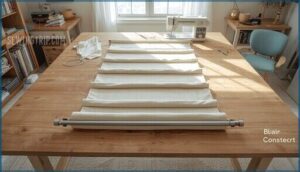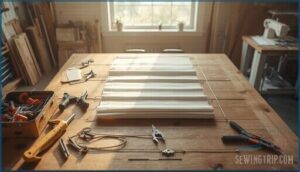This site is supported by our readers. We may earn a commission, at no cost to you, if you purchase through links.
 You’ve priced custom roman shades at three different shops, and the quotes made your wallet gasp. The good news? Making your own roman shades costs a fraction of what professionals charge—often 60-70% less—and you don’t need expert sewing skills to pull it off.
You’ve priced custom roman shades at three different shops, and the quotes made your wallet gasp. The good news? Making your own roman shades costs a fraction of what professionals charge—often 60-70% less—and you don’t need expert sewing skills to pull it off.
The process breaks down into five manageable steps: measuring your windows precisely, selecting the right fabric and hardware, calculating your material needs, constructing the shade with basic straight stitching, and installing the lift mechanism.
With accurate measurements and attention to a few key details during assembly, you’ll create customized window treatments that look professionally made while gaining the satisfaction of completing a functional DIY project that transforms your space.
Table Of Contents
Key Takeaways
- Making your own Roman shades costs 60–70% less than buying custom and doesn’t require advanced sewing skills.
- Precise window measurements and choosing between inside or outside mounts are essential for a professional fit and proper light control.
- Selecting the right fabric, lining, and hardware—like thermal or blackout materials, dowels, and lift cords—directly impacts the shade’s look and function.
- Careful cutting, sewing, and hardware installation ensure your shades hang straight, operate smoothly, and can be customized with decorative trims.
How to Measure Windows for Roman Shades
Getting your measurements right is the difference between shades that hang perfectly and ones that leave gaps or bunch awkwardly. You’ll need to decide on your mounting style and take precise measurements before you cut a single inch of fabric.
Here’s what to measure and how to do it accurately.
Inside Mount Vs Outside Mount
Where should you position your Roman shades—inside the window frame or outside? This choice impacts everything from light blocking to install flexibility.
Inside mounts fit within the window opening, creating clean, built-in aesthetics that preserve decorative moldings. Outside mounts attach to the wall or ceiling beyond the frame, offering enhanced light control and space perception benefits—they make windows appear larger. Inside mounts need at least 2 inches of frame depth, while outside mounts suit shallow openings. Inside mounts are ideal for modern interiors.
Here’s your quick comparison:
- Mount Aesthetics – Inside mounts showcase trim; outside mounts conceal imperfections
- Light Blocking – Outside mounts eliminate side gaps for better privacy
- Space Perception – Outside mounting can visually enlarge windows by 3-6 inches
- Install Flexibility – Outside mounts allow easier hardware placement and layering
- Cost Comparison – Inside mounts use 5-10% less fabric than outside installations
Choose inside mounts for sleek looks with visible window frames, or outside mounts when maximizing coverage matters most. Accurate window measurements depend on selecting your mounting brackets location first.
Measuring Width and Length
Once you’ve decided between inside and outside mounting, grab your steel measuring tape—it’s accurate within ±1/8 inch and delivers the precision these window measurements demand.
For inside width, measure at the top, middle, and bottom of the window frame. Record the smallest measurement to the nearest 1/8 inch. Manufacturers generally deduct 1/8–¼ inch for proper clearance.
For inside length, measure window height at the left, center, and right. Use the largest measurement, rounded up to 1/8 inch.
Outside mounts need different calculations. Add 2–4 inches to width (1–2 inches per side) for light-gap coverage. For length, measure from 3 inches above the frame to either the sill or 2 inches below it. To inside or outside mount a polished look, remember to decide between an inside or outside mount.
Measure each window separately—even identical openings vary by ¼ inch due to settling. When ordering multiple windows in one room, use the tallest height measurement across all shades to maintain level alignment.
Accounting for Overlap and Irregularities
Your window measurements often reveal surprises—frames settle, walls shift, and what looks square may be off by ½ inch or more. You’ll need to adjust for these realities if you want a shade that operates smoothly and blocks light effectively.
For outside mounts, add at least 1.5 inches overlap per side (3 inches total width) to cover gaps and improve light control. Extending 2–4 inches beyond the window opening reduces side leakage below 5%, especially when paired with blackout fabric.
When measuring windows for irregularities, check three spots horizontally and vertically. If your window size varies more than ¼ inch across, use the smallest width measurement to prevent binding. Depth requirements matter too—inside mounts need 2.5 inches minimum recess for standard headrails, while cordless systems demand 2⅛ inches.
Architectural issues like uneven casings or protruding molding? Add ⅛ inch trimming allowance per side, or use shims to level brackets up to ½ inch. For windows with cranks or levers, tack on an extra inch clearance to avoid operational snags.
- Overlap at least 3 inches total width for outside mounts to minimize light gaps and improve privacy
- Measure in three locations (top, middle, bottom) to catch frame irregularities exceeding ⅛ inch
- Verify window depth reaches 2.5 inches minimum before committing to inside-mount installation
- Use the narrowest measurement when horizontal variation tops ¼ inch to prevent shade binding
- Add 1 inch clearance per side when window opening includes levers, cranks, or other hardware obstructions
Recording Accurate Measurements
Once you’ve captured every dimension, your accuracy depends on how you write them down. Use a steel tape measure—it cuts errors to under 0.5% compared to cloth or plastic options—and record each value to the nearest ⅛ inch. Label width first, then height, to avoid mix-ups that plague over 30% of DIY projects.
Double-check your numbers on site; delaying documentation raises transposition errors by 13%, and measurement mistakes cost $450–$1,200 per remake.
Choosing Materials and Tools for Roman Shades
Getting your materials right makes all the difference between a smooth project and a frustrating one. You’ll need the right fabric, hardware, and a few essential tools to bring your Roman shades to life.
Here’s what to gather before you start cutting and sewing.
Best Fabrics for Roman Shades
Choosing fabric is where function meets design—and it makes or breaks your Roman shade project. Cotton and cotton blends offer excellent fold retention and work across most interior styles, representing over 25% of shade sales. Linen brings texture and durability, accounting for 45% of the segment, while polyester resists moisture and costs 35–50% less.
For shade insulation, thermal or blackout fabrics reduce heat loss by up to 14% and can lower cooling costs markedly in summer months.
Required Hardware and Supplies
You’ll need a headrail structure—a 1.5″ wood board secured with metal or plastic brackets (usually $3.50–$5.95 per set).
For lift mechanisms, grab cord locks, screw eyes (⅝”–¾” diameter), and nylon cord measuring seven times your shade length.
Don’t forget sew-on rings (½” diameter), dowel rods cut 1.5″ shorter than your shade width, and mounting hardware like angle brackets for heavier installations.
Selecting Lining and Dowels
Lining transforms your shade from decorative to functional. Thermal linings cut heat loss by up to 45%, while blackout options block nearly all light with a triple-pass coating. Standard polyester or cotton blends offer moderate light control at lower cost.
For dowel rods, fiberglass resists warping in humid conditions and outperforms wood by 50% under stress. Wooden dowels work well indoors and stay budget-friendly. Space dowels 8–12 inches apart for uniform folds, cutting each 1 inch shorter than your shade width.
Recommended Tools for DIY Projects
Your toolkit doesn’t need to break the bank, but quality makes the difference between smooth sailing and frustration. A reliable sewing machine manages medium-weight fabrics, while sharp fabric scissors prevent fraying during cuts.
You’ll need a metal measuring tape for accuracy to the nearest 1/8 inch, a power drill for bracket installation, and cord cutters for clean edges.
Add a sturdy needle for hand-finishing rings, and you’re set to build shades that rival store-bought options.
Calculating Fabric and Supply Requirements
Getting your fabric and supply measurements right from the start saves you from frustrating do-overs and wasted material. You’ll need to account for hems, dowel spacing, and lining—not just the visible window area.
Here’s how to calculate exactly what you need for a professional-looking shade.
Determining Fabric Width and Length
Getting your fabric width and fabric length right means the difference between a crisp, professional shade and one that bunches or sags. Start with your window dimensions, then apply these adjustments using your measuring tape:
- Fabric width: Add 4 inches to your desired shade width for side hems and turnings
- Fabric length with dowels: Divide window length by 9.5 inches, round to the nearest whole number, then add 1.5 inches per dowel for pockets
- Fabric length without dowels: Simply add 4 inches to your shade length for top and bottom hems
- Pattern repeats: Add one full repeat (usually 12–27 inches) if your fabric has a directional design
- Seaming allowance: For shades wider than 54 inches, calculate an extra 1 inch per seam for joining fabric panels
These material estimation guidelines guarantee you’ll have enough yardage while minimizing waste—most medium windows need roughly 2 yards of fabric.
Calculating Lining Size
Your lining fabric should measure 1 to 2 inches narrower than your finished shade width—this creates a ½-inch inset on each side that prevents puckering and maintains clean tension.
For fabric length, cut your lining 1 inch shorter than your face fabric to avoid sagging at the bottom fold.
If you’re adding dowel pockets, include an extra 1.5 inches per rod in your lining size calculations to accommodate the inserted dowels without distorting your fold calculations.
Estimating Dowels and Cord Needs
Once you’ve sized your lining, calculate dowels by dividing your shade length by your chosen dowel spacing—usually 8 to 12 inches apart. For a 68-inch shade with 9.5-inch spacing, you’ll need about 7 dowel rods cut 1 inch shorter than your finished width.
Cord length requires a bit more math: take your shade length, add 1.5 times the width, then multiply by your number of lift cords—usually spaced every 6 to 8 inches horizontally for balanced tension.
Allowing for Hems and Decorative Details
Beyond your initial allowances, factor in hems and finishing before you sew fabric. Standard bottom hems need 2 to 3 inches for a clean double fold, while side turnings take roughly 3 inches total. If you’re adding pom pom trim or other edge finishing, tack on another inch for secure stitching.
Cotton and linen shrink 2–5%, so prewash before fabric cutting to avoid pattern matching headaches.
Weighted dowel pockets require an extra 1 to 2 inches, and pleats look sharper when hem allowances lock in seam memory with proper pressing.
Cutting and Sewing Roman Shades
Once you’ve got your measurements and materials ready, it’s time to transform your fabric into a working shade. This step involves careful cutting, precise sewing, and creating the structural elements that give Roman shades their signature look.
Here’s how to turn those pieces of fabric into a finished window treatment.
Cutting Fabric and Lining to Size
Precision in cutting fabric determines whether your Roman shade hangs straight or ends up bunched and uneven. You’re working with fabric grain, measuring tape, and sharp cutting tools—and every eighth of an inch matters.
- Use a rotary cutter on a gridded mat to improve cutting accuracy by roughly 15% compared to scissors alone
- Cut your main fabric 3 inches wider and 5 inches longer than your finished shade dimensions to allow proper seam allowance
- Align cuts with the fabric grain to prevent distortion and guarantee your shade drapes correctly when raised or lowered
Cut your lining 1 inch narrower than the main fabric for clean finishing.
Sewing Side and Bottom Hems
With your fabric cut, hemming techniques lock those raw edges into place. Start with side hems: fold fabric 1/2 inch, press it flat, then fold again to 1 inch and straight stitch about 1/8 inch from the edge using your sewing machine.
Bottom hems need more fabric—fold up 8 inches, press, then sew 3/4 inch above the aligned edge. These hem allowances and folding methods create the structure your shade needs to hang straight and professional-looking.
Creating Dowel Pockets and Gussets
Once your hems are done, dowel pocket construction creates the backbone of your shade’s folds. Cut 2-inch strips of lining fabric, fold them in half lengthwise, and sew with a 1/4-inch seam allowance. Space these dowel pockets 8 to 12 inches apart on your shade’s back, bonding them with fusible web for a clean finish.
For gusset fabrication at the bottom, fold fabric up 2 inches, press flat, then stitch close to the fold—this pocket holds your heaviest dowel rod for proper weight distribution.
Adding Optional Piping or Trim
Piping techniques and decorative edging transform your shade from plain to polished. Insert piping between fabric and lining during side seams, using a zipper foot on your sewing machine for tight stitching. Grosgrain ribbon offers 20+ color choices, while Greek key trim adds upscale detail.
- Sew piping into seam allowances using a zipper foot for precision along fabric edges
- Pin trim before stitching to eliminate puckering, especially around corners and curves
- Match patterns carefully across joins to maintain visual flow and professional appearance
- Layer contrasting piping at top or bottom hems—65% of DIYers prefer this look
- Budget $2-5 per linear foot for quality trim, or shop seasonal sales for 50% savings
Assembling and Attaching Hardware
Once your shade is sewn and pressed, it’s time to bring it to life with the right hardware. This step transforms flat fabric into a functional window treatment that lifts and lowers smoothly.
Here’s how to install the dowels, rings, and cord system that make your Roman shade work.
Inserting Dowels and Wooden Slats
Once you’ve sewn your fabric pockets, it’s time for dowel placement—think of them as the skeleton that gives your shade its signature folds. Cut your wood dowels 1 inch shorter than the shade width to prevent binding, usually using 3/8-inch diameter dowel rods. Space fabric pockets 8 to 12 inches apart, then slide each dowel into its pocket.
The bottom requires a heavier slat of wood for proper weight distribution, ensuring smooth operation when attaching dowel rods later.
Attaching Rings and Cord Mechanism
Think of rings as the control points that turn a flat fabric into a functioning shade. Using a buttonhole or zig-zag stitch, attach blind rings every 8 to 12 inches vertically along each dowel pocket on the shade’s back. Space them 12 to 24 inches horizontally—closer ring placement creates crisper folds with better cord tension.
Install eye screws on your mounting board aligned with each vertical column, then add pulley systems and cord control locks. These mounting techniques and safety features guarantee smooth cord mechanism operation and child-safe function.
Threading and Securing Lift Cords
Cord threading is where your lift mechanisms come to life. Start at the bottom, securing cords with knots or orbs on each dowel. Thread 1.4mm to 2.0mm nylon string upward through every ring in vertical columns, then guide them through eye screws and into your cord control mechanism.
Choose cord materials based on fabric weight—thicker cords for heavier shades prevent stretching. Always install a safety cleat to wrap excess cord, meeting cord safety standards and eliminating strangulation hazards for children.
Installing and Adjusting Your Roman Shades
You’ve built the shade, threaded the cords, and now it’s time to get it on the wall.
This step covers how to mount your shade securely, finish the cord system cleanly, and add any final touches that make it yours.
Here’s what you need to know to complete the installation.
Mounting Inside or Outside The Frame
Your mounting choice shapes both function and aesthetic. Inside mount brackets secure directly into the window frame, requiring at least ¾ inch frame depth for stability, while outside mounting hardware attaches to the wall or ceiling surrounding your window—perfect for shallow frames or window obstructions.
Consider these installation tips when choosing mounting styles:
- Inside mounting creates a customized look that showcases trim but needs adequate frame depth
- Outside mounting visually expands window height and provides better light blockage through overlap
- Shade alignment depends on precise bracket placement—measure three times across your window frame before drilling
Match your mounting board and mounting hardware to your window’s unique conditions for professional results.
Securing Cord Cleat and Finishing Touches
Once your shade hangs properly, install two cord cleats vertically on the wall—spaced 6 to 12 inches apart and at least 64 inches high—to keep lift cords out of children’s reach and meet current safety standards.
Wrap cords in a figure-eight pattern around the cleats, trim excess length, and test your shade’s operation to confirm smooth, tangle-free lifting across all panels.
Adding Decorative Elements for Customization
With your shade fully functional, consider adding textile accents to enhance its design. Contrast-colored fringe along the bottom edge brings vibrant energy to neutral tones, while velvet ribbons or beaded tassel trims introduce textural depth.
You can apply decorative edging with simple sewing techniques—think piping between pleats or pom pom trim that softens sharp lines.
Custom hardware and fabric embellishments like embroidered borders transform basic shades into designer-level pieces, unifying your room’s color scheme with thoughtful trim options and fabric selection.
Frequently Asked Questions (FAQs)
Should I line my roman shades? What are the benefits?
Why settle for unlined Roman shades when lining delivers serious wins? Lining boosts Light Control, blocks UV rays for Fabric Protection, adds Thermal Insulation for Energy Efficiency, and even provides Noise Reduction—making your DIY Roman shades a smarter window treatment choice.
What size dowels are recommended? What is the standard size?
You’ll generally use 1/4 inch dowels for most DIY projects—it’s the standard dowel diameter that balances strength and flexibility.
For larger shades or heavier fabric weight considerations, upgrade to 3/8 inch dowels to prevent sagging and maintain crisp folds in your dowel pockets.
How do you clean and maintain Roman shades?
Think of dust as an unwelcome houseguest—it settles in, makes itself comfortable, and refuses to leave without gentle persuasion. Vacuum Roman shades weekly with a soft brush attachment for dust removal, spot-clean stains immediately with mild detergent and lukewarm water for proper fabric care, and schedule professional cleaning annually to preserve your DIY Roman shades and window treatment investment.
Can Roman shades be motorized or automated?
Yes, Roman shades can be motorized or automated using cordless systems powered by batteries, hardwired connections, or solar panels.
Motorized shades integrate with smart home platforms, offering remote control, voice commands, and programmable schedules that improve energy efficiency and safety.
Whats the best way to remove wrinkles from fabric?
Steam the fabric with a handheld steamer, holding it a few inches away.
For ironing, use low heat on delicate fabrics and higher heat on cotton or linen. Keep fabric slightly damp to ease wrinkle removal.
How long does it take to make Roman shades?
Transforming a stack of fabric into a stunning window treatment feels like conquering a mountain—but it’s more manageable than you think.
Construction time for DIY Roman shades usually ranges from 4 to 8 hours for beginners, while experienced sewers finish in 4 to 6 hours. Sewing complexity, fabric selection, and project duration depend on your chosen style—flat shades are quickest, while hobbled designs add 1 to 2 hours.
Can you use patterned fabric for Roman shades?
Patterned fabric works beautifully for Roman shades, but pattern scale and fold styles matter. Smaller, densely packed patterns handle folds better than large repeats, which can distort when lifted.
Geometric and stripe patterns suit flat fold styles, while florals add softness to traditional designs.
Conclusion
Think of your window as a blank canvas, and each step in how to make roman shades as a brushstroke shaping light and privacy. With careful measuring, thoughtful material choices, and patient assembly, you create something customized and lasting.
The finished shade isn’t just fabric and cord—it’s a daily reminder of your skill and intention. As the shade rises and falls, it reflects your ability to shape your surroundings with confidence and creativity, one project at a time.
- https://www.onlinefabricstore.com/makersmill/how-to-make-a-roman-shade/
- https://www.archivemarketresearch.com/reports/roman-blinds-529995
- https://www.blindsgalore.com/blog/index.php/windowpedia/energy-saving-benefits-of-roman-shades/
- https://thediymommy.com/sew-a-diy-roman-shade/
- https://www.diydecormom.com/diy-roman-shade-2/














